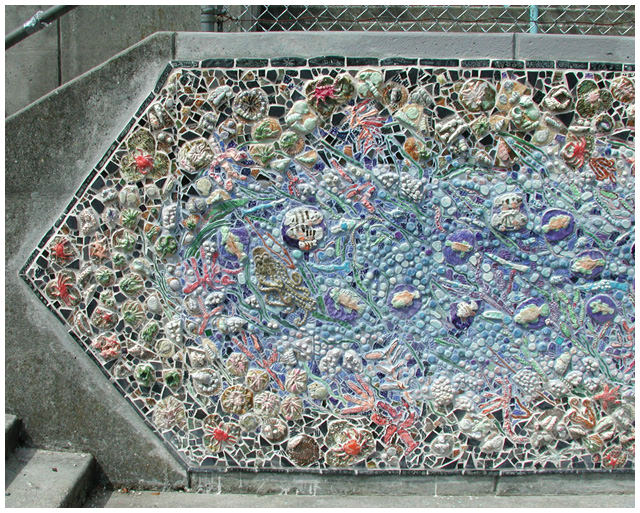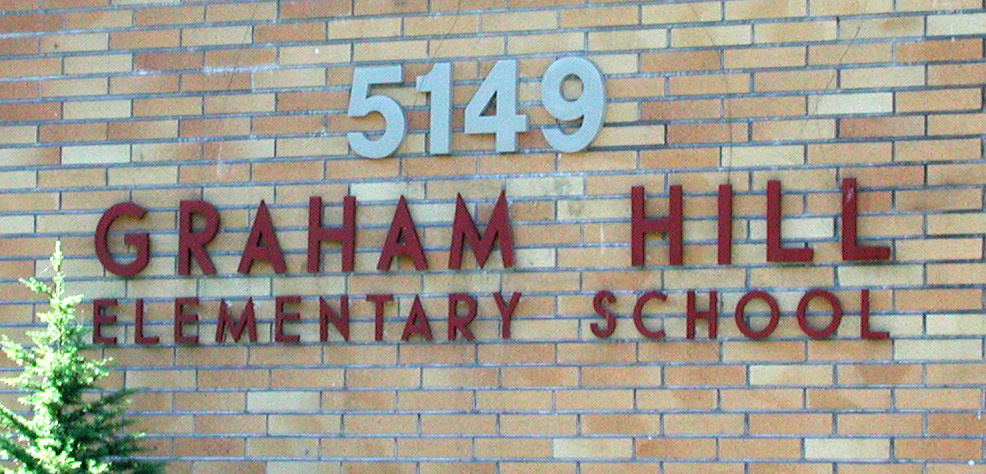
Graham Hill Elementary School, Seattle, WA – Salmon cycle :: 2004.
This outdoor art installation resulted from a residency at Graham Hill Elementary School, Seattle WA and was a collaboration between Julia Cole, Deirdre Daw and Leigh Rosser. The materials were primarily high-fire ceramic tiles and mosaics, and water-jet cut and powder-coated steel. The installation included six different projects that were related to the salmon life cycle. Salmon are important in the ecology of the Pacific Northwest, and the school had recently installed a tank in the school entryway that grew salmon hatchlings into larger fish.
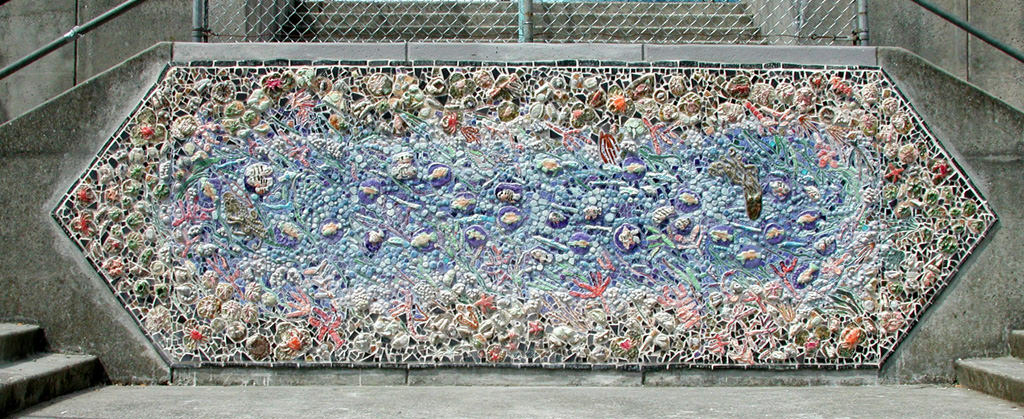
Graham Hill Elementary School, Seattle, WA – Salmon cycle: Tide Pool Mural, high fire ceramic and glass, 12’ x 5’ x 1”:: 2004.
Students at all levels created the creatures, rocks, vegetation, water elements, and diatom border for this tide pool mosaic. We brought the parts together into a final composition.
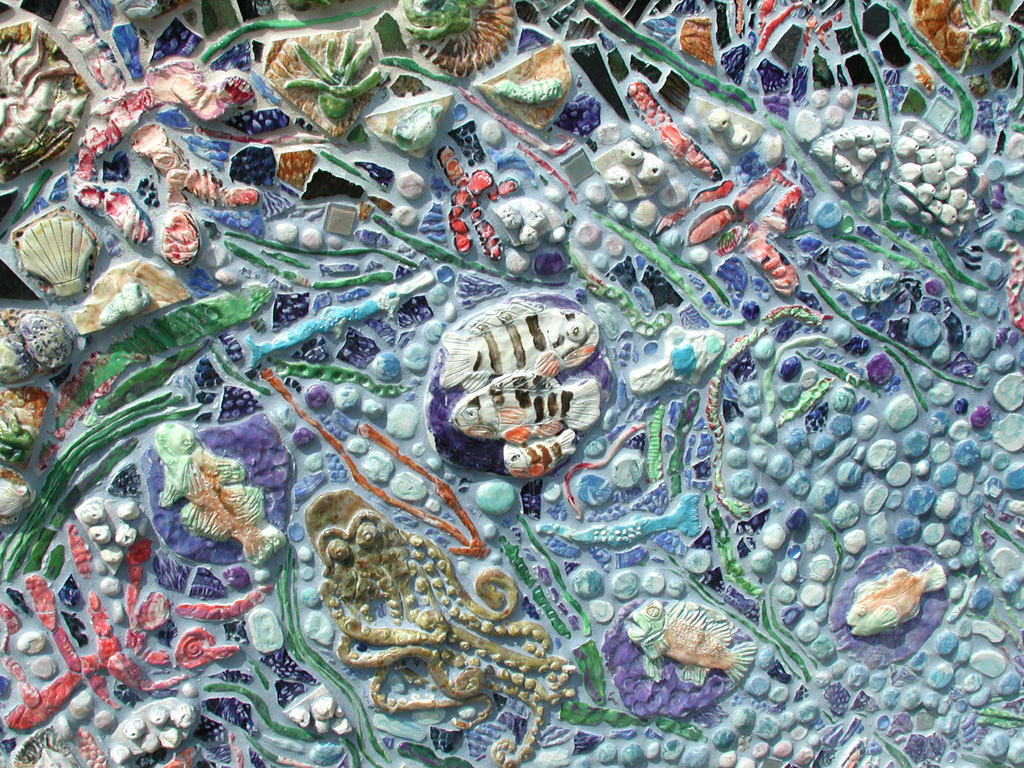
Graham Hill Elementary School, Seattle, WA – Salmon cycle: Tide Pool Mural, high fire ceramic and glass, detail :: 2004.
Close up in the center of the mural showing anemones, barnacles and bivalves, seaweeds, various fish, octopus, and marbled water tiles. The youngest children made the water tiles by mixing two colors of clay together, rolling out sausages and then slicing them up.
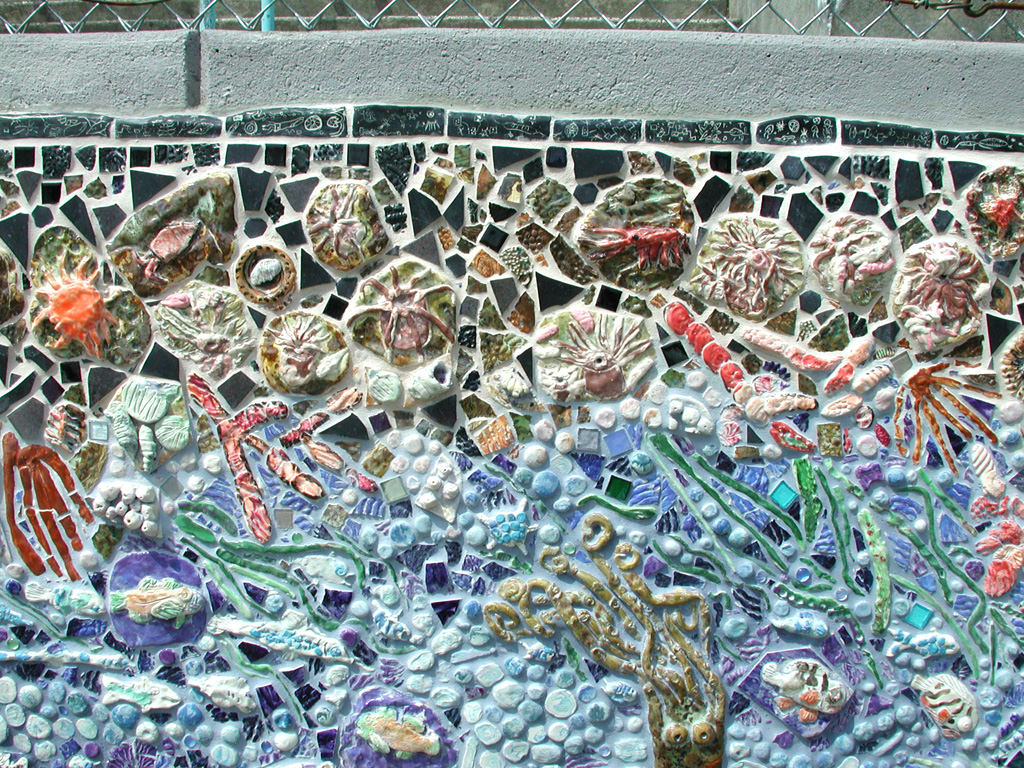
Graham Hill Elementary School, Seattle, WA – Salmon cycle: Tide Pool Mural, high fire ceramic and glass, detail :: 2004.
Mural edge close up showing the diatom border. This part of the installation focused on the saltwater phase of the salmon life cycle. We chose a tide pool because so many of the species are ones that students could encounter easily on a trip to the shore.
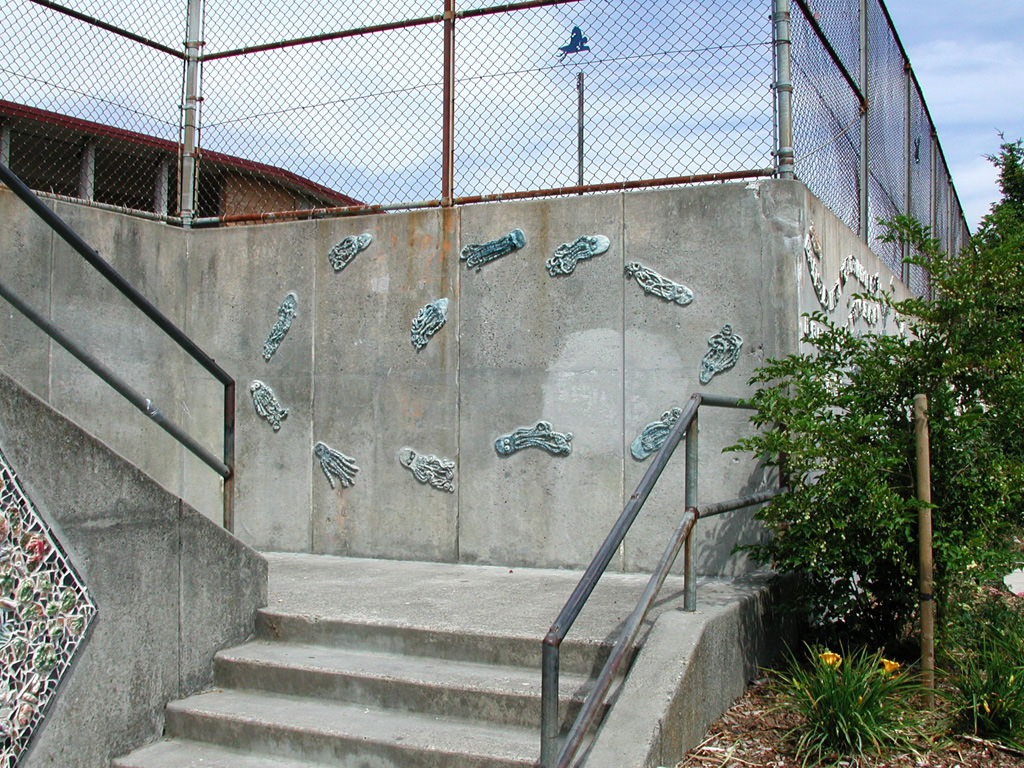
Graham Hill Elementary School, Seattle, WA – Salmon cycle: Octopus school, high fire ceramic, approximately 6’ x 12’ x 1“ :: 2004.
The kids who made these octopi could not believe how great they looked when they were done. We had thought we would just use a couple of the octopi in the tide pool, but these were all so amazing that we had to install a couple of octopus schools in the stairwell.
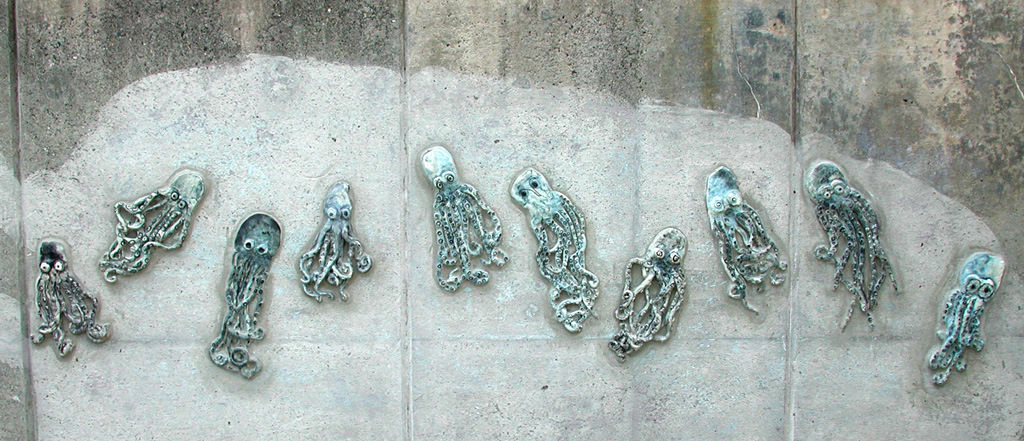
Graham Hill Elementary School, Seattle, WA – Salmon cycle: Octopus school, high fire ceramic, approximately 2’ x 12’ x 1“ :: 2004.
Octopus circle. The expressions on the “faces” of the octopi were quite varied and engaging.
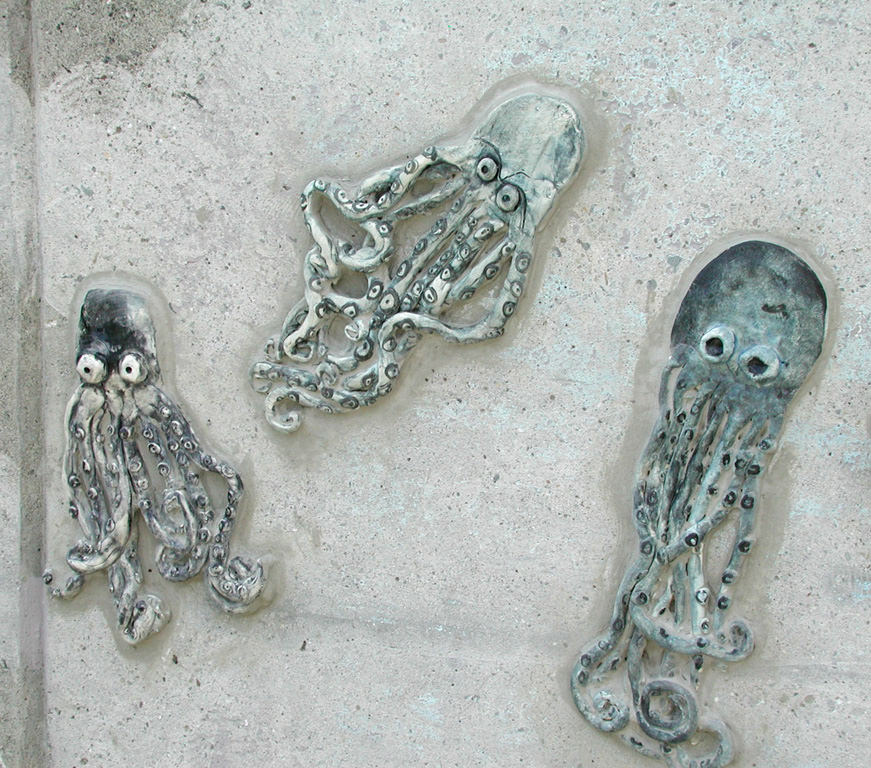
Graham Hill Elementary School, Seattle, WA – Salmon cycle: Octopus school, high fire ceramic, approximately 3’ x 3’ x 1“ :: 2004.
Three octopi.
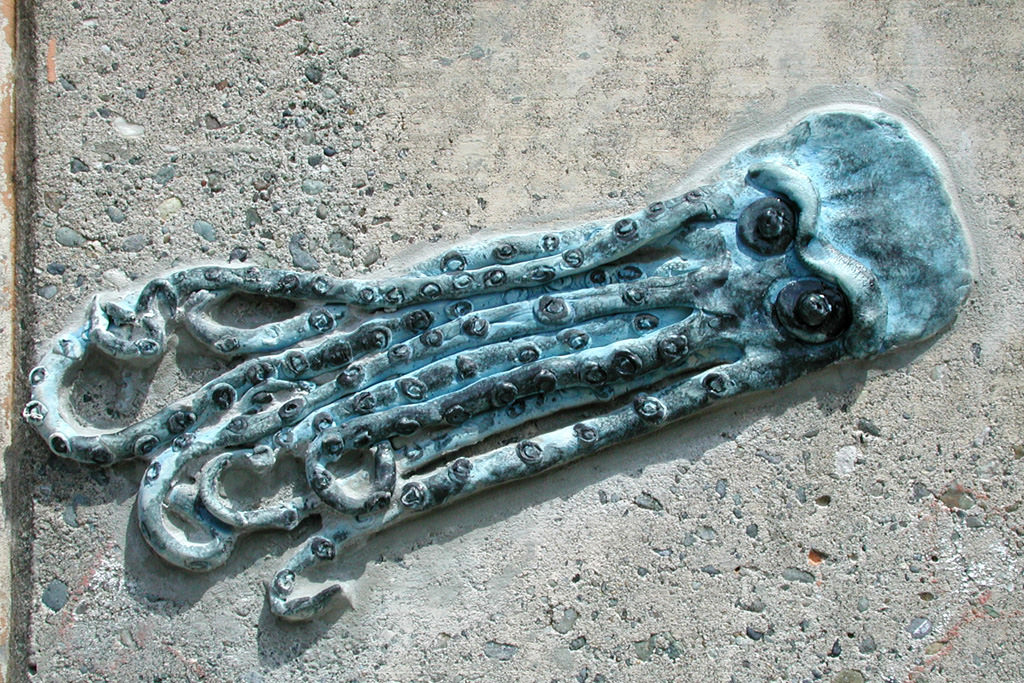
Graham Hill Elementary School, Seattle, WA – Salmon cycle: Octopus school, high fire ceramic, approximately 12” x 6” x 1“ :: 2004.
Single octopus.
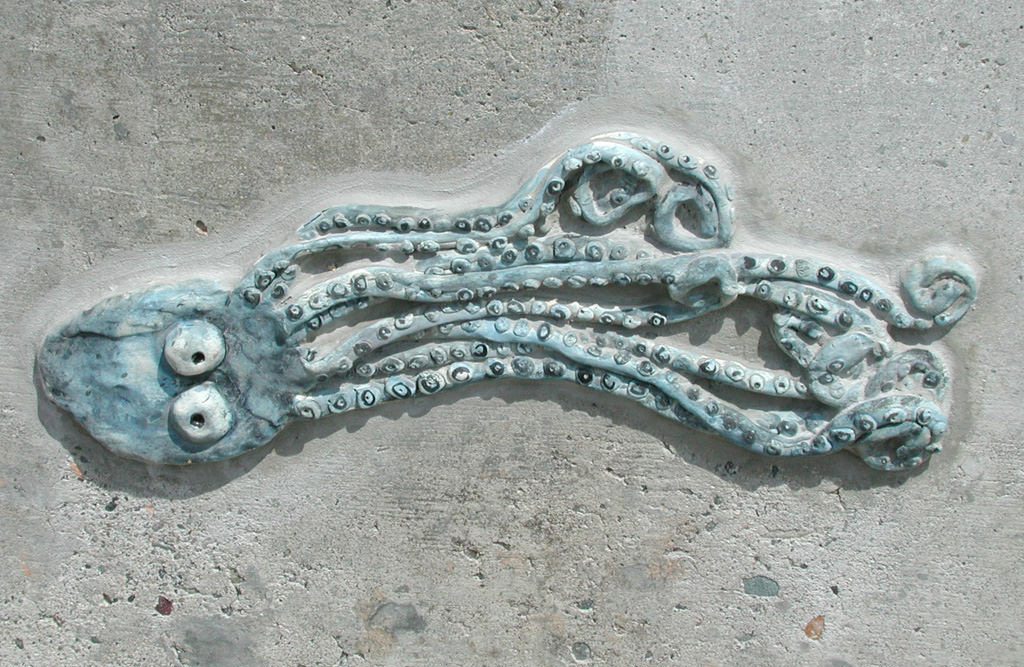
Graham Hill Elementary School, Seattle, WA – Salmon cycle: Octopus school, high fire ceramic, approximately 12” x 6” x 1“ :: 2004.
Single octopus. This one may look a little surprised because it has nine legs.

Graham Hill Elementary School, Seattle, WA – Salmon cycle: Shore birds, water jet cut steel, powder coating, approximately 24” x 30” x 1” :: 2004.
Pelican. Leigh worked with children in one class to design simple silhouette shapes of seashore birds. The students chose the birds they liked the best.

Graham Hill Elementary School, Seattle, WA – Salmon cycle: Shore birds, water jet cut steel, powder coating, approximately 24” x 24” x 1” :: 2004.
Duck. We mounted the bird silhouettes on the rusty old chain link fence around the schoolyard.

Graham Hill Elementary School, Seattle, WA – Salmon cycle: Shore birds, water jet cut steel, powder coating, approximately 18” x 24” x 1” :: 2004.
Hawk.
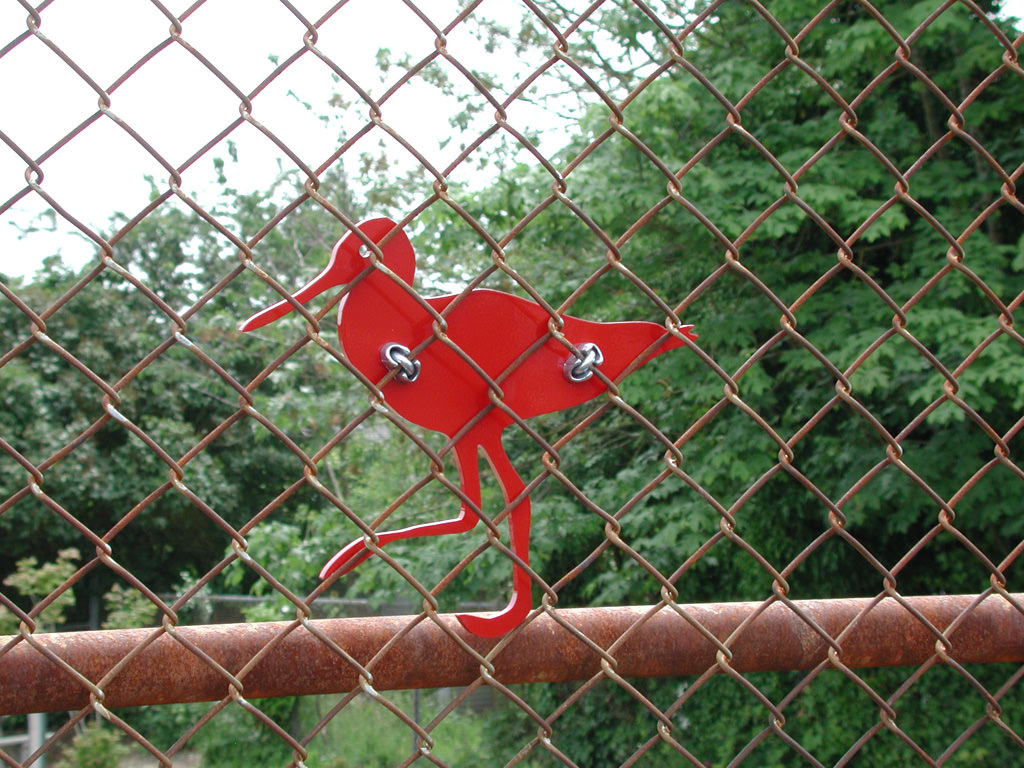
Graham Hill Elementary School, Seattle, WA – Salmon cycle: Shore birds, water jet cut steel, powder coating, approximately 12” x 12” x 1” :: 2004.
Sandpiper.
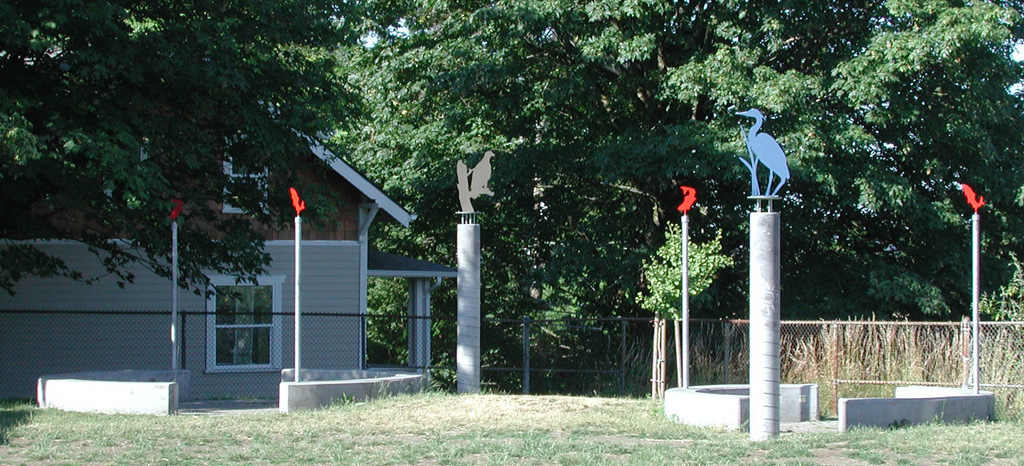
Graham Hill Elementary School, Seattle, WA – Salmon cycle: Freshwater fisher birds and salmon, water jet cut steel and powder coating, installation :: 2004.
Two talking circles with eagle and heron and four salmon finials. One of the parents on the PTA was an architect, and he had donated his time to the school to create this outdoor space for classes to gather. Leigh made the freshwater fisher birds to go on top of the columns, as well as the four leaping salmon finials on the flagpoles.
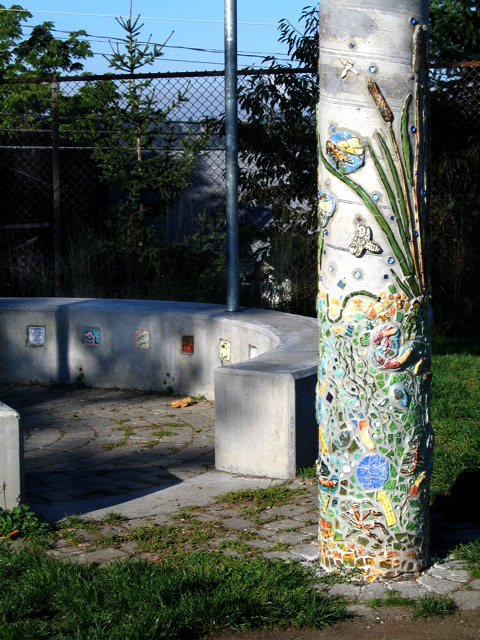
Graham Hill Elementary School, Seattle, WA – Salmon cycle: Freshwater fisher birds and salmon, water jet cut steel and powder coating, installation, heron is approximately 24” x 36” x 1” :: 2004.
Column and circle with heron and salmon. We thought of this whole area as the freshwater phase of the salmon life cycle. We based the materials on studies of this habitat, including salmon predators and prey.

Graham Hill Elementary School, Seattle, WA – Salmon cycle: Freshwater fisher birds and salmon, water jet cut steel and powder coating, installation, salmon is approximately 6” x 12” x 1” :: 2004.
Close up of salmon and heron. During the Grand Opening the poles were used to suspend drawings of salmon made by the students.

Graham Hill Elementary School, Seattle, WA – Salmon cycle: Freshwater stream, high fire ceramic tiles and glass, columns are approximately 6 ‘ tall :: 2004.
Close up of column and circle. The two concrete columns next to the talking circles became sites for more mosaics. All the creatures and vegetation in the mosaics on these were from the streams where salmon spend part of their lives.
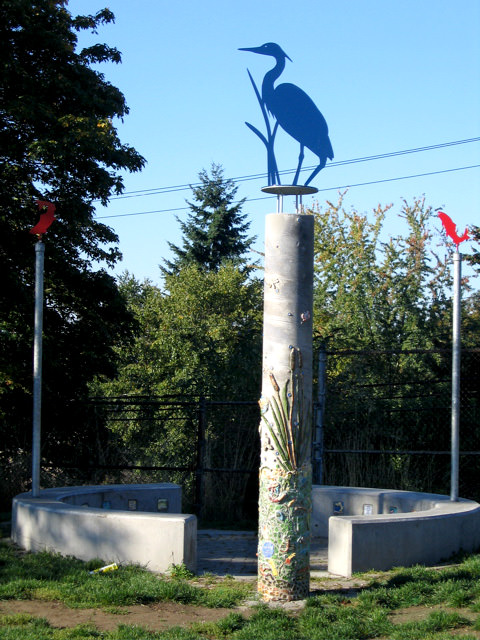
Graham Hill Elementary School, Seattle, WA – Salmon cycle Freshwater stream, high fire ceramic tiles and glass, detail :: 2004.
Close up of a column. Deirdre made text arrows that identified some of the species we had looked at with the students.
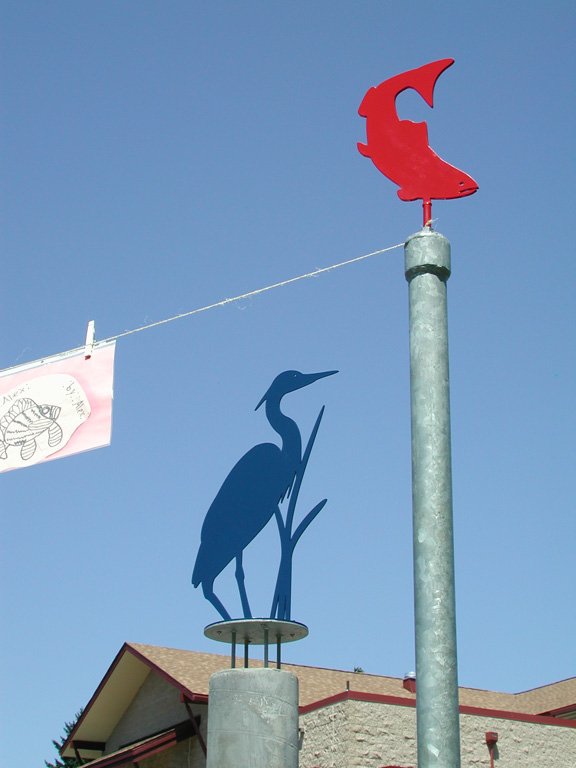
Graham Hill Elementary School, Seattle, WA – Salmon cycle Freshwater stream, high fire ceramic tiles and glass, detail :: 2004.
Close up of a column.
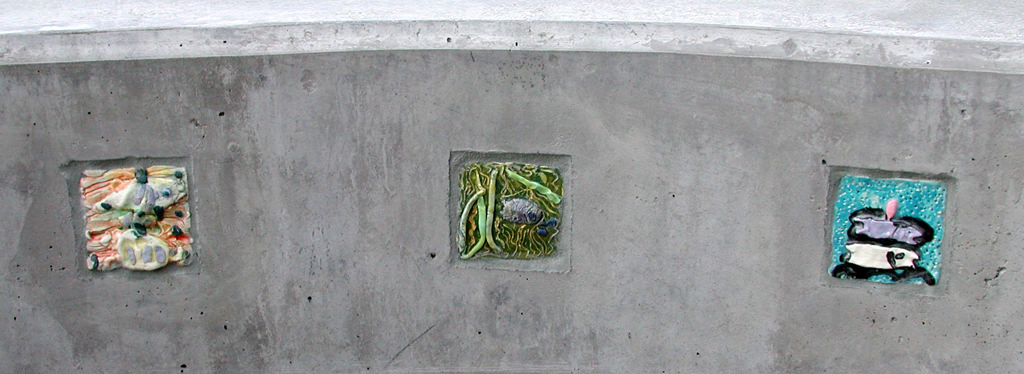
Graham Hill Elementary School, Seattle, WA – Salmon cycle: Freshwater fish tiles, high fire ceramic, each tile approximately 4” x 4” x 2 “ :: 2004.
Tile insets in the talking circle. A couple of classes made tiles to fit into the small recesses that had been left in the talking circle benches by the builders. These were all imaginative renderings of fresh water fish.

Graham Hill Elementary School, Seattle, WA – Salmon cycle: Freshwater fish tiles, high fire ceramic, each tile approximately 4” x 4” x 2 “ :: 2004.
Tile insets in the talking circle.

Graham Hill Elementary School, Seattle, WA – Salmon cycle: Freshwater fish tiles, high fire ceramic, each tile approximately 4” x 4” x 2 “ :: 2004.
Tile insets in talking circle.
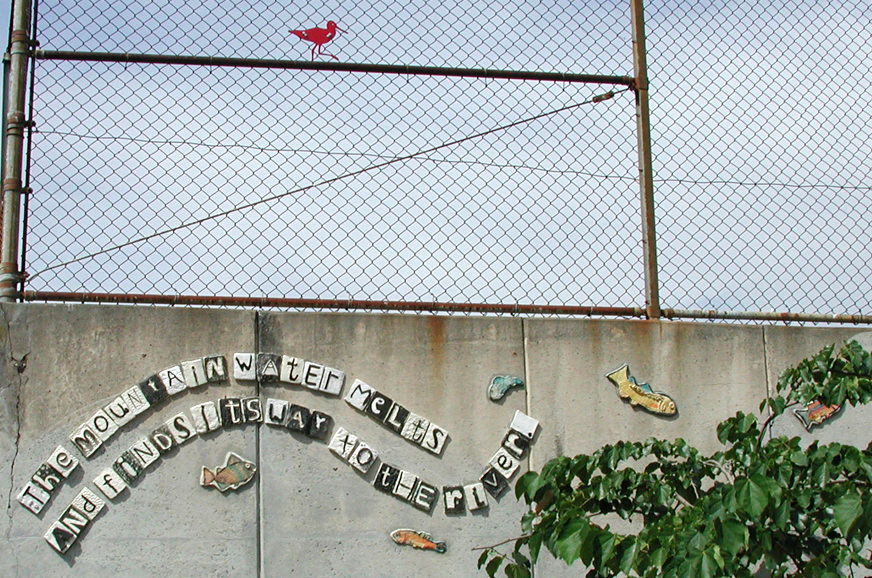
Graham Hill Elementary School, Seattle, WA – Salmon cycle: Poem Line, high fire ceramic, each tile approximately 6” x 6” x 1” :: 2004.
Poem line with sandpiper. We asked a Seattle poet to come in and work with a couple of classes to write a poem about the salmon’s life. Then we broke the poem down into its component letters and the kids made them out of clay.
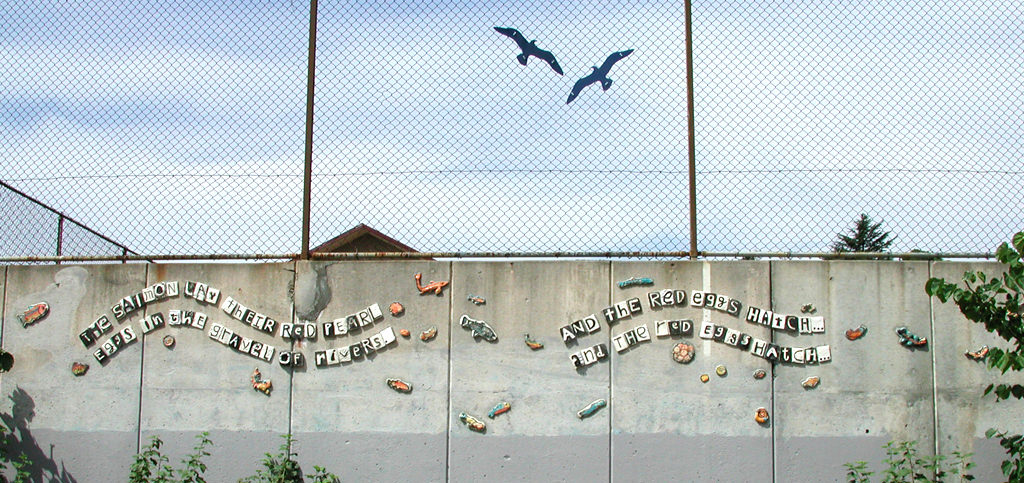
Graham Hill Elementary School, Seattle, WA – Salmon cycle: Poem Line, high fire ceramic, each tile approximately 6” x 6” x 1” :: 2004.
Poem line and gulls. Other children made eggs, embryos, hatchlings and grown salmon to float and swim around the text.
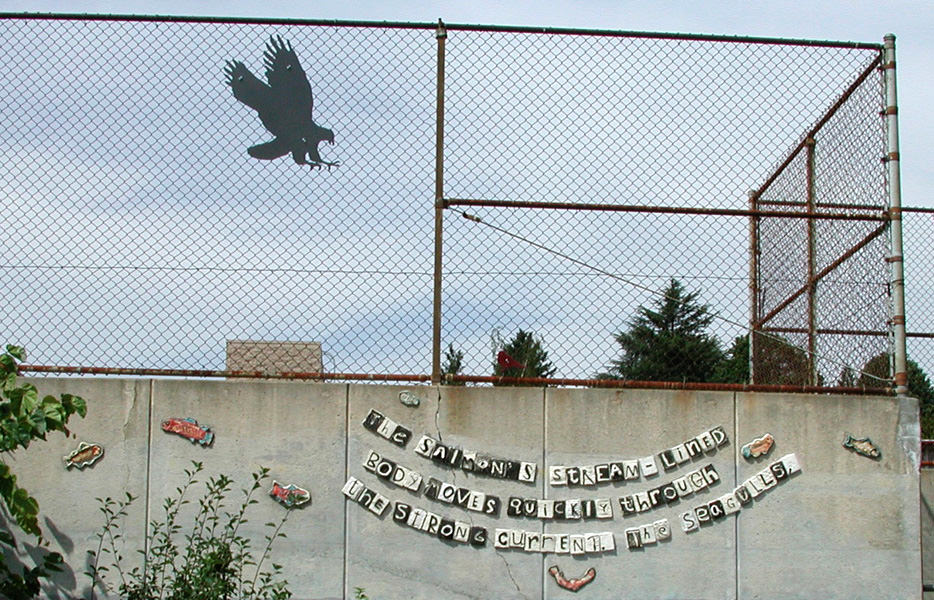
Graham Hill Elementary School, Seattle, WA – Salmon cycle: Poem Line, high fire ceramic, each tile approximately 6” x 6” x 1” :: 2004.
Poem line and eagle. The poem allowed the children to imagine the life of the salmon not just as a series of stages of development, but as a part of a larger cycle of life and death in which all living creatures participate.
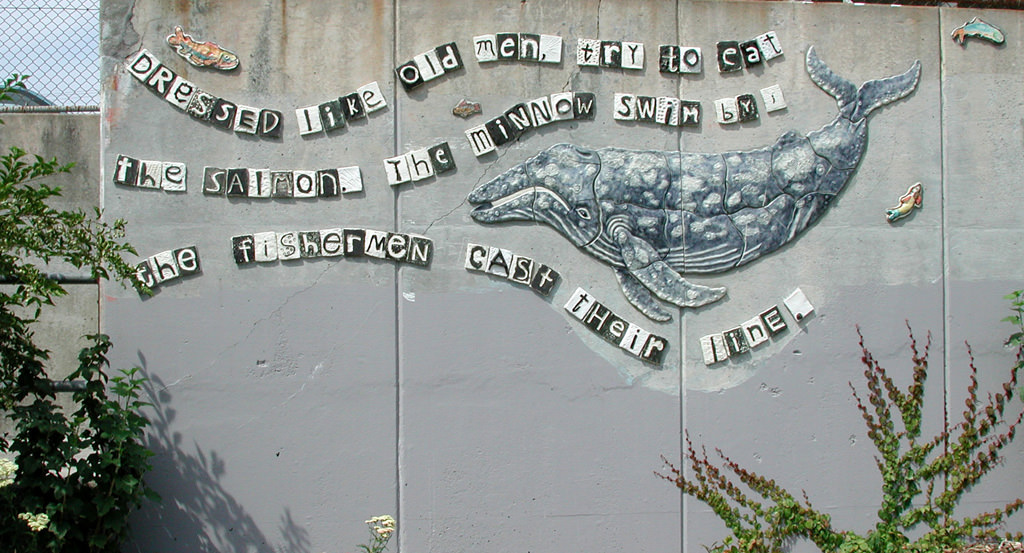
Graham Hill Elementary School, Seattle, WA – Salmon cycle: Poem Line, high fire ceramic, each tile approximately 6” x 6” x 1”, whale is approximately 5’ x 3’ x 1” :: 2004.
Whale and poem line. Julia made the whale. It wasn’t really part of the salmon life cycle, but the school really wanted one as a mascot…
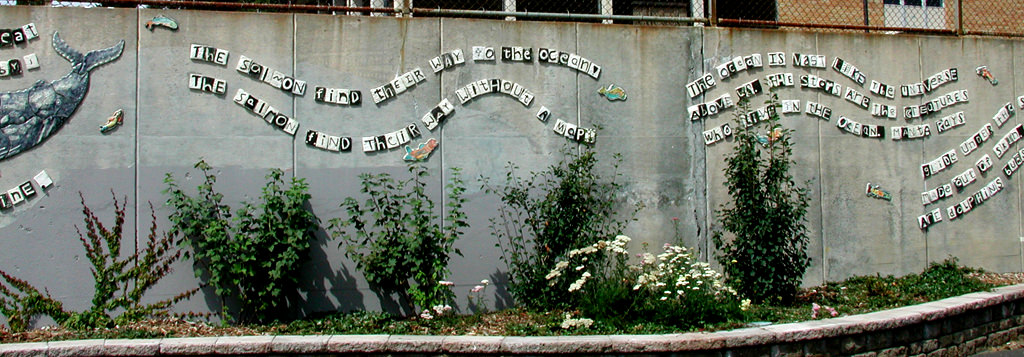
Graham Hill Elementary School, Seattle, WA – Salmon cycle: Poem Line, high fire ceramic, each tile approximately 6” x 6” x 1” :: 2004.
Poem line.

Graham Hill Elementary School, Seattle, WA – Salmon cycle: Poem Line, high fire ceramic, each tile approximately 6” x 6” x 1” :: 2004.
Poem line whole right end with whale, pelican, hawk, duck, sandpipers on the fence above. We really needed the parents’ help to install this poem wall, but it was a lot of fun working together. Lot’s of people showed up, and we got most of the work installed in a single day.
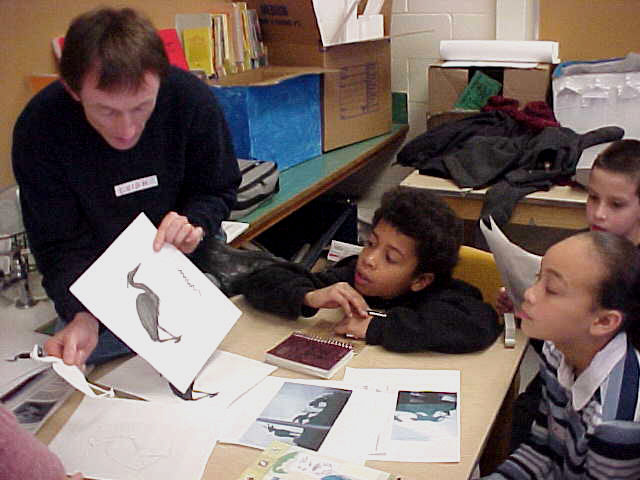
Graham Hill Elementary School, Seattle, WA – Salmon cycle: Teaching component :: 2004.
Leigh teaching. He showed the students how to scan their drawings into a computer, and explained how the birds would be water-jet cut from steel.
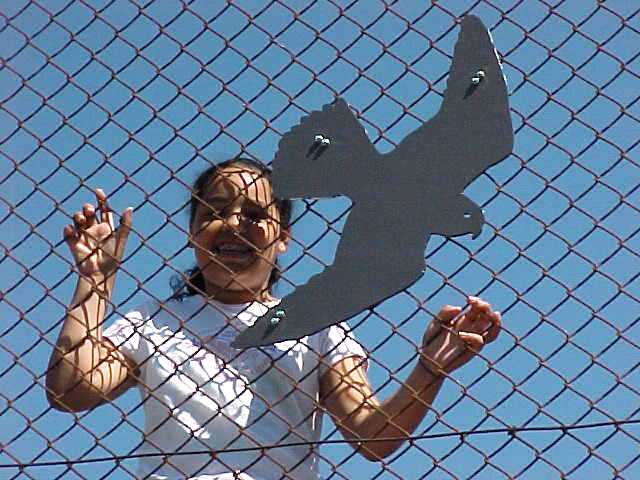
Graham Hill Elementary School, Seattle, WA – Salmon cycle: Teaching component :: 2004.
Student with the hawk she worked on.
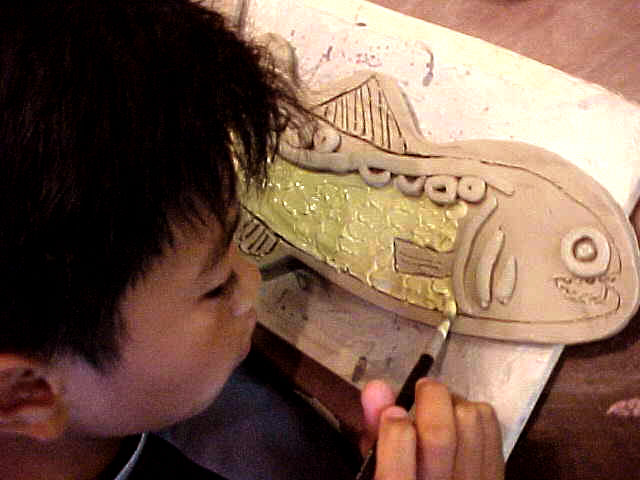
Graham Hill Elementary School, Seattle, WA – Salmon cycle: Teaching component :: 2004.
Boy glazing a salmon. The younger children worked on a different project each time they came, but older ones would come back and glaze something they made in a previous session. This allowed them to see more complex projects through to completion.
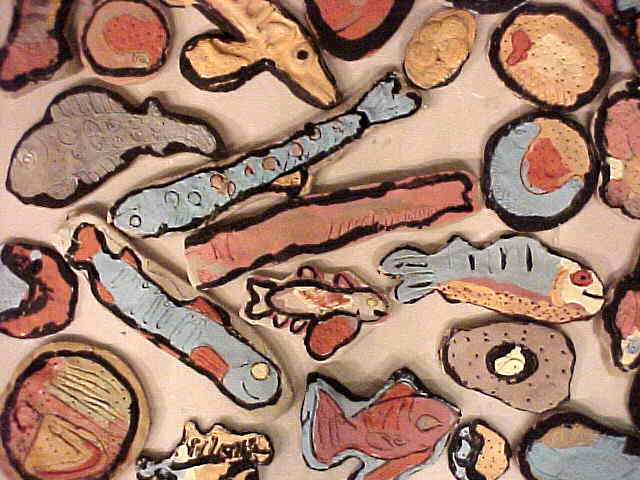
Graham Hill Elementary School, Seattle, WA – Salmon cycle: Teaching component :: 2004.
Eggs and developing salmon, glazed but not fired. These are the elements that were mounted on the wall around the poem line. The process of egg hatch and development of the young fish had particular relevance to the students because of the fish tank in their entry hall.

Graham Hill Elementary School, Seattle, WA – Salmon cycle: Teaching component :: 2004.
Making the diatom border. The kids really like the pictures of diatoms, and enjoyed the simple process of scratching through the glaze to draw their abstract shapes.
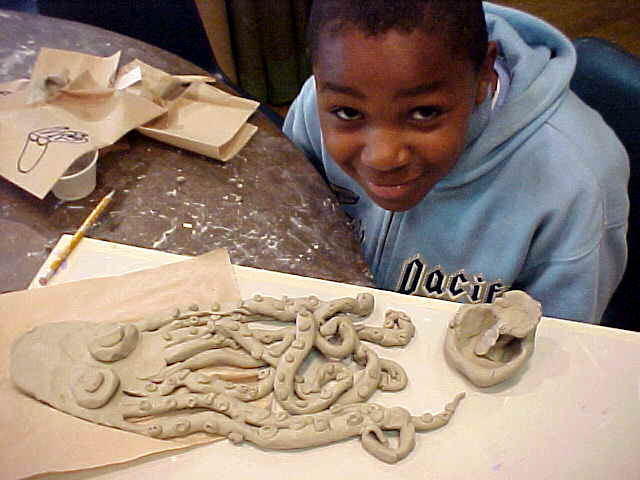
Graham Hill Elementary School, Seattle, WA – Salmon cycle: Teaching component :: 2004.
Making an octopus. We would draw first with the kids, showing them how to make the basic shapes for the different kinds of fish, anemones, crabs, shells, starfish, seaweeds and so on. As we drew, we would pass around things we had gathered on the shore, and talk about life in a tide pool and how salmon spend part of their lives in the ocean.
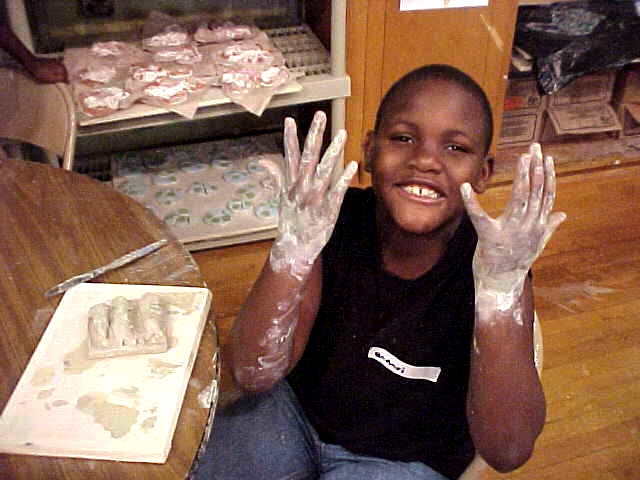
Graham Hill Elementary School, Seattle, WA – Salmon cycle: Teaching component :: 2004.
Making tiles. This student is working on making a letter tile for the poem wall. Deirdre and Julia prepared the slabs of clay for the tiles, and then the children either cut designs into these or applied coil shapes to their surface. They then glazed either the positive or negative space around the letterform, rendering them legible from a distance.
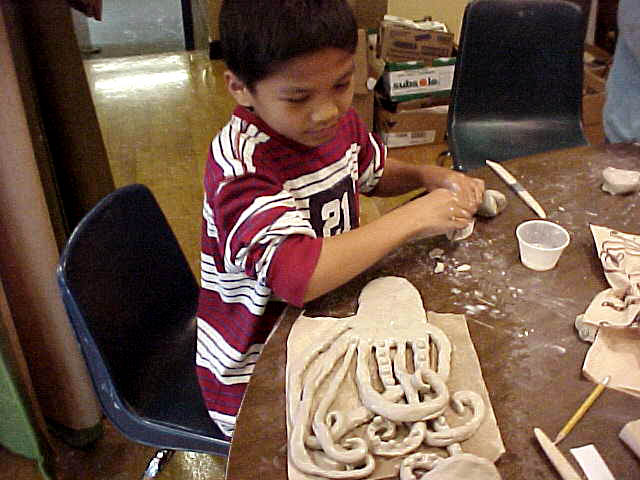
Graham Hill Elementary School, Seattle, WA – Salmon cycle: Teaching component :: 2004.
Making another octopus. We were astonished at how few hand-eye coordination skills most of the students had (some had never learned to use scissors), and at the level of low self-esteem among the older kids. Even in the short span of our engagement with these students, we were able to see how much difference this program made, generating a joyful sense of achievement and ownership.

Graham Hill Elementary School, Seattle, WA – Salmon cycle: Teaching component :: 2004.
Focused making. While there were some discipline issues in the first classes, we found that as the children grew more confident in their abilities and invested in the project, they would focus their energy in a much more productive way.
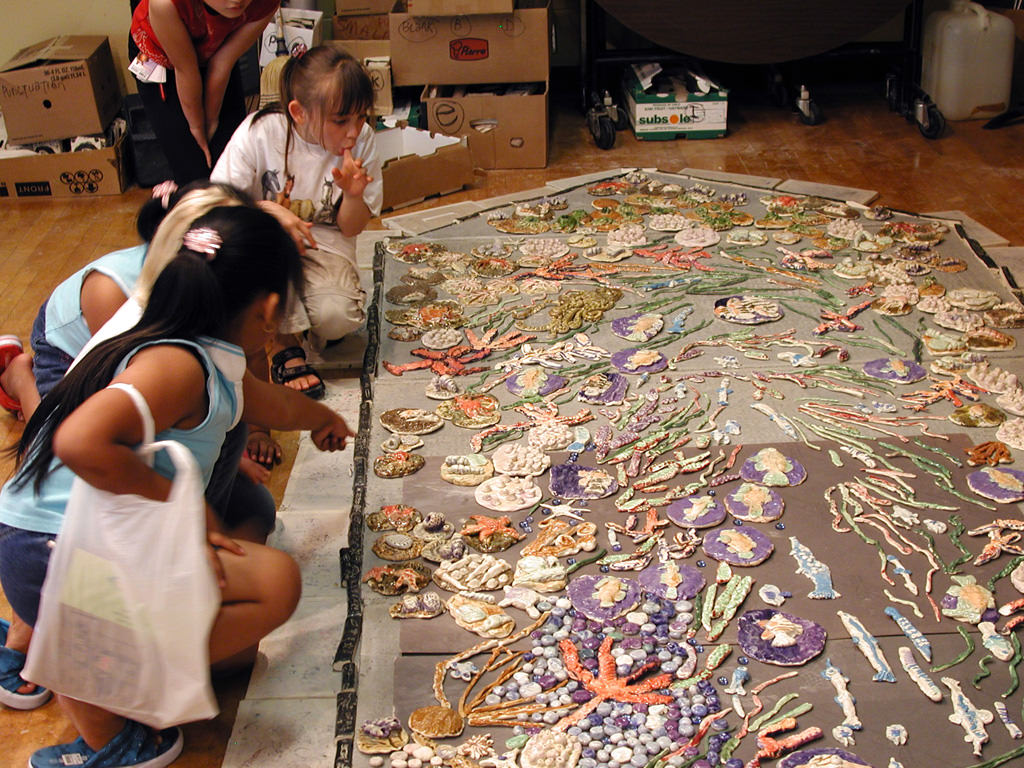
Graham Hill Elementary School, Seattle, WA – Salmon cycle: Teaching component :: 2004.
Kids looking at the mural in the process of composition. We worked on the stage, and even after the classes were over students would come by to see how the project was progressing and point out the elements that they had made to their friends. After we left the school, we heard that the premises had been tagged, but the artwork had not been touched, and we think this is because the community felt that they really owned the work.
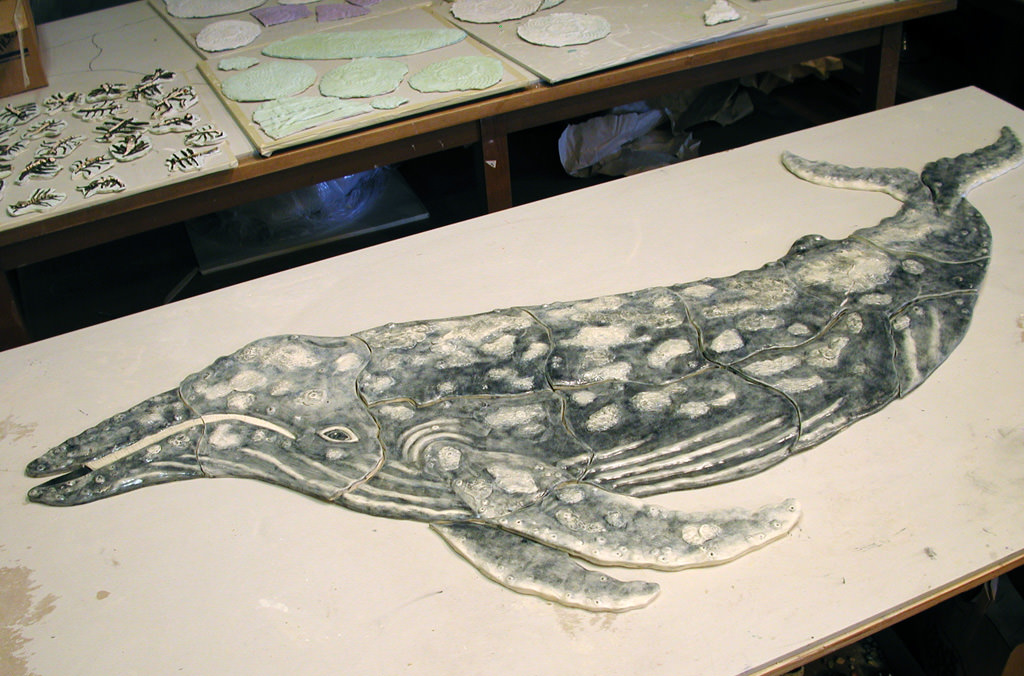
Graham Hill Elementary School, Seattle, WA – Salmon cycle: Teaching component :: 2004.
Whale with stain before firing and glazing, When we made elements for the installation ourselves, we tried to do so where the students and teachers could watch the process. We think it is empowering to witness the skills of project management in action, and also to understand how making something special requires vision, commitment, experimentation and time spent alone.


